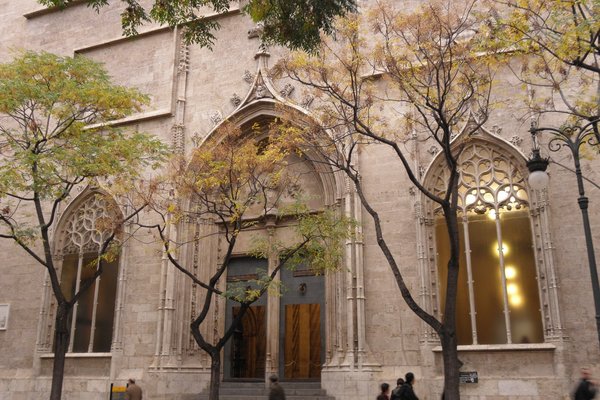Spain
La Lonja de la Seda
La Lonja de la Seda de Valencia is a 15th-century Gothic masterpiece that was used as a trade hall and silk exchange.
This commercial building became a symbol for the Golden Age of Valencia when it was one of the great Mediterranean mercantile cities. It still is used for commercial purposes. The complex includes the main Contract Hall, the Pavillion of the Consulate which was the seat of the Tribunal del Mar and the central crenellated tower.
Community Perspective: This smallish site is closed on Mondays and there is a small entrance fee. The spiral pillars of the main trading hall are seen as its Gothic highlight. Valencia overall is a good destination for a city break, especially for its modernist City of Arts and Sciences.
Site Info
Official Information
- Full Name
- La Lonja de la Seda de Valencia (ID: 782)
- Country
- Spain
- Status
-
Inscribed 1996
Site history
History of La Lonja de la Seda
- 1996: Inscribed
- Inscribed
- Type
- Cultural
- Criteria
- i
- iv
Links
- UNESCO
- whc.unesco.org
- Official
-
- valencia-cityguide.com — La Lonja
All Links
UNESCO.org
- whc.unesco.org — whc.unesco.org/
Official Website
- valencia-cityguide.com — La Lonja
Community Information
- Community Category
- Human activity: Transport and Trade
Travel Information
Recent Connections
-
Perfect Inscriptions
1996 -
Untranslated Toponyms
The Silk Exchange in Valencia -
Valencia Hotspot
Connections of La Lonja de la Seda
- History
-
-
Located in a Former Capital
Kingdom of Valencia (1237-1707)
-
- Architecture
-
-
Grotesques
"It is lit by soaring Gothic windows, the external frames of which, like the doors, are exuberantly ornamented, notably by a series of grotesque gargoyles." (AB ev) -
Gothic
-
Renaissance
Many of the decorations date from the Renaissance, including the gargoyles and one of the wooden ceilings
-
- World Heritage Process
-
-
Perfect Inscriptions
1996
-
- Human Activity
-
-
Historical Financial Institutions
it housed the Taula de Convis i Deposits, a banking institution -
Silk Manufacture
Silk trade
-
- Constructions
-
-
Prison
"On occasions, the Tribunal would imprison merchants for debts in the central tower of La Lonja - the third part of the structure."
-
- Timeline
-
-
Built in the 15th century
founded in 1469
-
- WHS Hotspots
- WHS Names
-
-
Untranslated Toponyms
The Silk Exchange in Valencia
-
News
No news.
Recent Visitors
Visitors of La Lonja de la Seda
- 2Flow2
- Adolfo
- Afshin Iranpour
- aleserre
- alex
- Alexander Barabanov
- Alexander Lehmann
- Alikander99
- Allan Berry
- Ammon Watkins
- Antonio J.
- Argo
- arnaugir
- Artur Anuszewski
- Aspasia
- Atila Ege
- BaziFettehenne
- Bill Maurmann
- Bin
- Boj
- Bram de Bruin
- Carlo Medina
- Caspar
- chenboada
- Christine
- Christravelblog
- Claire Bradshaw
- ClaraHH
- Clyde
- Cobaltrage
- Colossus
- Cristina Erba
- Csaba Nováczky
- CugelVance
- czesioszpachelka
- Dagmara
- Daniela Hohmann
- Daniel Chazad
- Danieljbromberg
- Danny L
- Dan Pettigrew
- David Aaronson
- David Berlanda
- del
- Dimitar Krastev
- Dimitrios Polychronopoulos
- Dolemite92
- Don Irwin
- Dorejd
- Dreamcatcher
- Dwight Zehuan Xiao
- Elia Vettorato
- eljx1988
- Els Slots
- Emilia
- Erik Jelinek
- Evgenii
- Fam39
- Fan Yibo
- Farinelli
- Feldhase
- Femke Roos
- Filip Murlak
- forest80
- Francky D'Hoop
- GabLabCebu
- Gary Arndt
- Geert Luiken
- George Gdanski
- GeorgeIng61
- grimloch
- Grzegorz Andruszkiewicz
- Hadrianus
- Hammeel
- HaraldOest
- Harald T.
- Harry Mitsidis
- Hubert
- Iain Jackson
- Ian Cade
- Ivan Rucek
- James Bowyer
- janameerman
- Jan-Willem
- Jarek Pokrzywnicki
- Jarrod_Byham
- Jasam
- Javier
- Jawnbeary
- Jeanne OGrady
- Jens
- Jezza
- Joel on the Road
- Jonas Hagung
- Jonas Kremer
- Jon Eshuijs
- Joyce van Soest
- KarenBMoore
- Karito Vies
- Kbecq
- Ken DJ
- kiank37
- Klaus Freisinger
- KngAlaric
- Krijn
- Lara Adler
- LaVale
- Lisu Marian
- Lithobates
- Loic Pedras
- Luboang
- Lucio
- Luis Filipe Gaspar
- Lukasz Palczewski
- Maciej Gil
- Maciej Gowin
- Malgorzata Kopczynska
- Manuelfunk
- Marlies van Wolfswinkel
- Martinacurra88
- Martina Rúčková
- Marton Kemeny
- Matthewsharris
- MAURO PODDA PANI
- MH
- M. Huineman
- Michael Novins
- Michael Turtle
- Mikan22
- Mikko
- Milan Jirasek
- Msarmiento1979
- nan
- napalm
- NH1984
- Nick M
- Nihal Ege
- Olli-Pekka Turunen
- PabloNorte
- palka25
- Paola Laura
- Patrik
- Patrik_globe
- Paul Schofield
- Persian Globetrotter
- Peter Lööv
- Petteri
- Philipp Leu
- Philipp Peterer
- Pink Bunny
- Piotr Wasil
- Porcho
- Purrfect
- Qin Xie
- Ralf Regele
- Randi Thomsen
- Reiseblog
- Reisedachs
- Reza
- Riccardo Quaranta
- Rick Ohm
- Roel Sterken
- rogerding
- Roger Ourset
- Roman Bruehwiler
- Sabrina Liebehentschel
- Sandmann15
- Sandra!
- scubarrie
- serghei.belous
- Sergio Arjona
- Shandos Cleaver
- sibariam
- Solivagant
- Sorel Americo
- Stan
- Stanislaw Warwas
- StaziG
- stephanvermeulen
- Svein Elias
- Szabolcs Mosonyi
- Szabo Viktoria
- Szucs Tamas
- Tamara Ratz
- Taotao Chen
- Tarquinio_Superbo
- Tevity
- Thomas Buechler
- Thomas van der Walt
- Tim Allen
- tingmelvin
- tommasorossotti
- Tonisan
- triath
- Tsunami
- Twobaconsandaboston
- ValiaVeweth
- Vanessa Buechler
- Viaje al Patrimonio
- voyager
- Walter
- WILLIAM RICH
- Wojciech Fedoruk
- wolfboy
- Xander Huang
- Xiong Wei
- Zach
- Zoë Sheng
Community Reviews
Show full reviews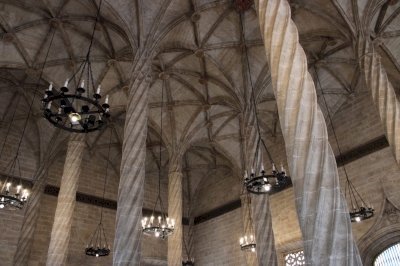
La lonja de la seda is a peculiar WHS, especially for Spain, where single monument WHS are a rarity. There is good reason for this. The rest of valencia, though beautiful is not really WHS worthy. As such to represent the city, once Capital (de facto) of the Crown of aragon, the city hall chose one monument: la lonja de la seda. La llotja was built between the 15th and 16th century in levantine gothic (based on la llotja dof la palma) with some renaissance influences. The building is quite modest in size and inside decoration. Its main attractive is the spectacular "sala de contratacion" with its spiral columns. The ceiling from la sala de contrataciones is another highlight. What really sold Unesco on the building was its overall conservation state. The building has been in almost continuous use as a mercantile institution since its founding. As such it has been taken care off remarkably well. apart from a few additions in the 19th century and the loss of the original paint job, it looks basically the same as when it was built.
Icomos recommends, in their now ancient report, that a study of mercantile builidings along the mediterranean be done. However it also notes that given its amazing preservation and "outstanding intrinsic artistic qualities" the inscription of the llotja should not be deferred.
so... what did I think of the building? it's pretty small and not as breathtaking as I imagined. Forget a forest of columns, the …
Keep reading 0 comments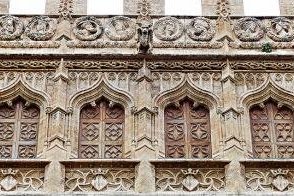
I visited this WHS in March 2016. I found a very good last-minute low-cost deal and booked straight away, totally unaware that the Fallas Festival was in full swing. I found out about the Fallas Festival after booking my flight and rental car as ALL the hotels in Valencia were fully booked! In the long run it only meant I had to modify my initial plans for the rock art visit and I slept in Elche instead which was very cheap. The main difficulty I encountered was parking once I arrived close to Valencia's city centre. All the main parking lots were either closed or not accessible as the Fallas floats were blocking every other street. After a few attempts and U-turns I parked my rental car at Garaje Guimerá which is just 1km away from the Lonja de la Seda. I was lucky to be there early in the morning as it was completely full in the afternoon. I could have used the metro from the airport to get there but I managed just the same. The festive atmosphere all over Valencia enhanced the overall experience as on the whole there isn't much to see apart from the silk exchange, the cathedral and the Plaza de Toros in the city centre. On the way back from Elche, I visited the City of Arts and Sciences and although I'm not a fan of modern architecture I would be in favour of its inscription on the WH list. Since I visited …
Keep reading 0 comments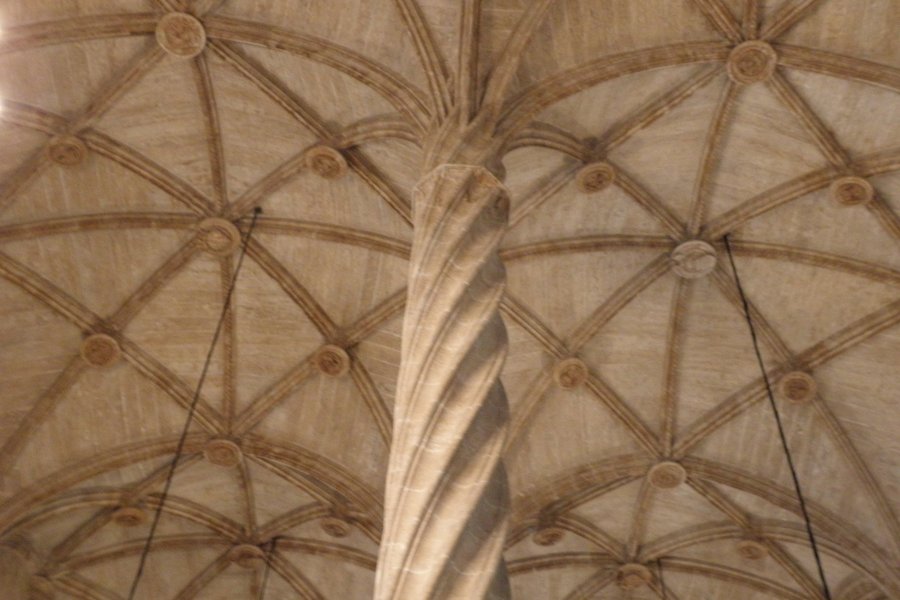
I went to the Valencia Silk Market with a couple of friends in June 2014. It is located opposite the Central Market, which is a wonderful covered market housing many dozens of food stalls. Being in a place like this makes one realise how homogenised and bland the food shopping experience has become back home.
The Silk Market costs €2 to get in, which is cheap of course, but it’s not a large building. The reason it was inscribed on the UNESCO list is because it is one of the best examples in the world of secular Gothic architecture, and was used for its original purpose for more than 500 years.
The silk that was traded here was harvested in the surrounding countryside from the cocoons of silkworms that inhabited the mulberry tree. Although they don’t exactly look alike, there is a reference to trees in the Sala de Contratación (trading hall), where the columns meet the roof in a manner designed to evoke palm trees.
Another interesting feature of the building is the stereoscopic – or 3D – floor. There is also an unconventional spiral staircase, constructed without a central column. This was done to show off the marvellous wealth of the city. Unfortunately you can’t walk up it, though you can use a different staircase to get to the upper floor.
In terms of the visiting experience, the market could be improved by some English descriptions. As it stands, the signs are all in Spanish only, so it …
Keep reading 0 comments
Somehow I can't quite agree with the positive reviews below. I do not deny the historic and architectural merits of the Silk Exchange, nor its WH value. It's quite an interesting building with some nice features (the columns in the main hall, the ceiling on the upper floor, the courtyard), and it certainly has its place in the history of business and economics. The problem is just that the organization and presentation are really terrible. The guided tours and the movie are only in Spanish (I do understand it reasonably well, but still, Valencia is full of international tourists, and the nearby cathedral, famous for its "Holy Grail", has audioguides and brochures in a whole bunch of languages) and there is nothing in the way of explaining what you can see (there are no signs or brochures whatsoever). So after walking around the building for about 15 minutes, there is nothing more to do and you have ticked off another WH site without having increased your knowledge of it at all. The upside is that the fee is only 2 Euros (as of 2012), and of course Valencia has a lot of other attractions, especially the impressive City of Arts and Sciences.
Keep reading 0 comments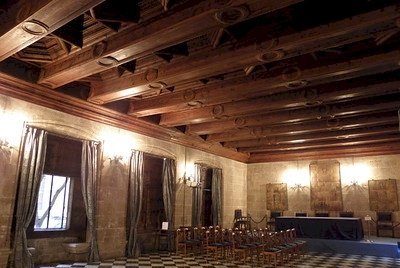
This is only one building, so my visit wasn't too long. At the entrance, I opted for the guided tour, which turned out to be very informative and was conducted (in Spanish) on a one-to-one basis. The start of the tour is in the main hall, which I also found to be the most impressive part of the building. It is no coincidence that it looks like the interior of a cathedral, as the wealthy merchants decided to emulate the religious symbolism because their trade was looked down upon.
The large, spiralled columns that dominate this hall represent palm trees: the columns used to be painted brown, their tops green and the ceiling sky blue. What a difference that must have been! Now all is the same kind of grey, a bit like when you're visiting Roman ruins and all those monuments look the same colour too.
The rest of the complex consists of a courtyard, a chapel (with a pretty Renaissance wooden ceiling) and the tribunal room on the second floor (also with an excellent ceiling). Although the main rooms are quite empty and austere, in the corners, around doors and windows, there are tiny sculptures. They often are grotesques and it is a delight to check them out. Actually, I visited La Lonja twice (the batteries of my camera ran out halfway during the first visit) and didn't regret it. There are a lot of interesting details, and I liked the atmosphere in the evening when …
Keep reading 0 comments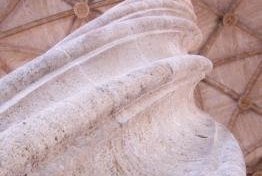
Valencia is one of those cities that make me love travelling in Europe. Whilst I really enjoy visiting the big cities Paris, London, Rome etc. it is the dense cluster of smaller cities that make travelling around the continent really rewarding and also account for the huge concentration of World Heritage Sites in this small part of the world.
La Lonja de la Seda is a pretty impressive monument to Mediterranean mercantile trade, and as outlined by David below has some fine gothic architectural detailing, and I am in full agreement that the one truly exceptional part of this are the spiral pillars of the main trading hall (picture). The courtyard garden and ceiling in the upper chapel are also very nice. On the whole though la Lonja is nice but nothing that I would really say was exceptional.
One quibble I have with the site is that aside from two signs displaying the WHS symbol there is absolutely no information on why this is an important/ exceptional building, there were free tours every hour or so, but unfortunately my Spanish is terrible so I couldn’t take advantage of this. It would be nice just to have an explanatory board or leaflet/ guidebook available, I had to rely on the advisory body report on the UNESCO website to put this place in some sort of context.
Anyway this was far from an unrewarding ‘city break’. La Lonja sits in a nice part of the old town with a wonderful ‘Modernisme’ …
Keep reading 0 comments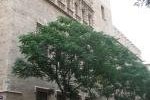
In our travel around Spain we have been to the beautiful city of Valencia and have visited the Lonja de la Seda (Silk Exchange), a nice group of buildings built between 1482 and 1533 in Late Gothic Flamboyant style, originally used for silk trading and then for commerce in general. The rectangular space of the Lonja includes the huge Trading Hall, the square Tower with the Chapel, the Consulate and the garden.
The exterior of the buildings (to visit it well you have to see all the façades) is crenellated and finely decorated with ornamented windows and doors (the main doorway is the nicest), gargoyles, coat of arms and religious and profane sculpture. The most noteworthy features of the exterior are certainly the nicely decorated windows of the upper floor of the Consulate, also with portrait medallions and gargoyles, forming a sort of gallery. The exterior of the buildings is certainly nice, but in my opinion it isn’t exceptional, because there are many palaces comparable to this one.
The interior is opened from 9.15 to 14 and from 17.30 to 21 (in winter from 16.30 to 20); it is always closed on Monday and on Saturday and Sunday there is a free ticket. The main feature of the Lonja is the enormous Trading Hall. It is divided in three aisles by five rows of incredibly high and strange spiral columns (this is in my opinion the only one feature of the Lonja really stunning, even if it isn’t unique; for …
Keep reading 0 comments
